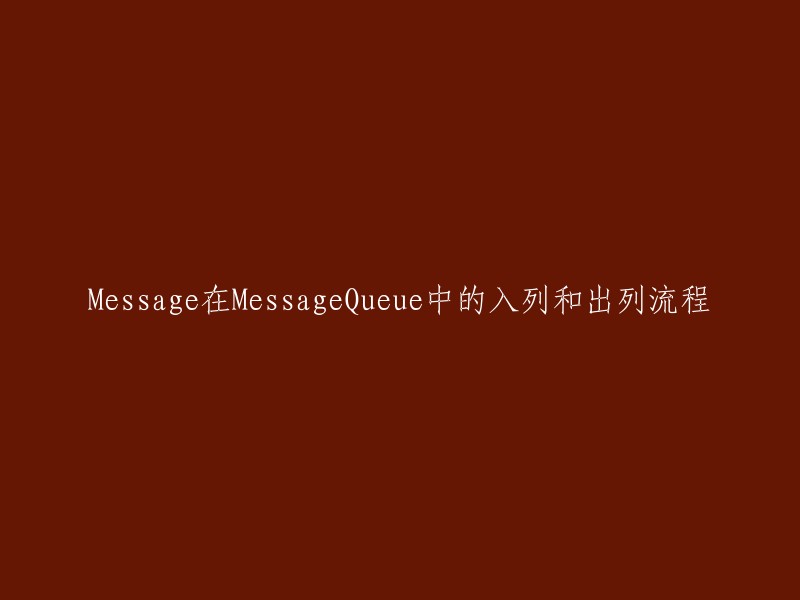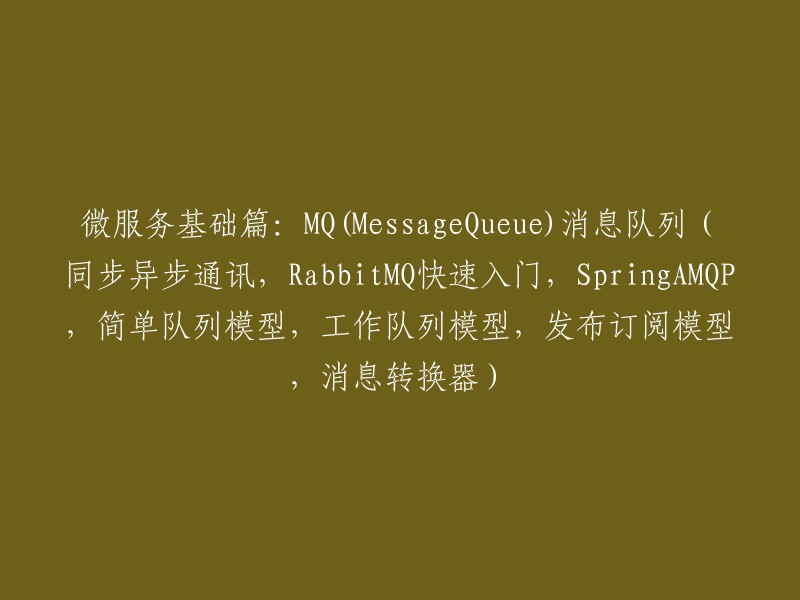MessageQueue类是一个参考类,它定义了对“消息队列”服务器上的队列的访问。这个类继承自System.ComponentModel.Component和System.Collections.IEnumerable接口。在某些情况下,这个类可能与预发行产品相关,因为在发布之前可能会进行重大修改。需要注意的是,Microsoft对于此处提供的信息不作任何明示或暗示的担保。
MessageQueue类的代码如下:
```csharp
[System.ComponentModel.TypeConverter(typeof(System.Messaging.Design.MessageQueueConverter))]
public class MessageQueue : System.ComponentModel.Component, System.Collections.IEnumerable
{
// ... 其他代码 ...
}
```
```
[System.ComponentModel.TypeConverter(typeof(System.Messaging.Design.MessageQueueConverter))]
[System.Messaging.MessagingDescription("MessageQueueDesc")]
public class MessageQueue : Component, IEnumerable
{
// 定义一个消息队列
private Queue
// 向队列中添加消息
public void SendMsgToQueue(string msg)
{
_queue.Enqueue(msg);
}
// 从队列中获取并移除消息
public string GetMsgFromQueue()
{
return _queue.Dequeue();
}
// 实现 IEnumerator 接口的 GetEnumerator 方法
public IEnumerator GetEnumerator()
{
return _queue.GetEnumerator();
}
}
```
```csharp
using System;
using System.Messaging;
namespace MyNewQueueDemo
{
public class MyNewQueue
{
// References public queues.
public void SendPublic()
{
var myQueue = new MessageQueue(".\\myQueue");
myQueue.Send("Public queue by path name.");
}
// References private queues.
public void SendPrivate()
{
var myQueue = new MessageQueue(".\\Private$\\myQueue");
myQueue.Send("Private queue by path name.");
}
// References queues by label.
public void SendByLabel()
{
var myQueue = new MessageQueue("Label:TheLabel");
myQueue.Send("Queue by label.");
}
// References queues by format name.
public void SendByFormatName()
{
var myQueue = new MessageQueue("FormatName:Public=5A5F7535-AE9A-41d4 -935C-845C2AFF7112");
myQueue.Send("Queue by format name.");
}
// References computer journal queues.
public void MonitorComputerJournal()
{
var computerJournal = new MessageQueue(".\\Journal$");
while (true)
{
var journalMessage = computerJournal.Receive(); // Process the journal message.
}
}
// References queue journal queues.
public void MonitorQueueJournal()
{
var queueJournal = new MessageQueue(".\\myQueue\\Journal$");
while (true)
{
var journalMessage = queueJournal.Receive(); // Process the journal message.
}
}
// References dead-letter queues.
public void MonitorDeadLetter()
{
var deadLetter = new MessageQueue(".\\DeadLetter$");
while (true)
{
var deadMessage = deadLetter.Receive(); // Process the dead-letter message.
}
}
// References transactional dead-letter queues.
public void MonitorTransactionalDeadLetter()
{
var TxDeadLetter = new MessageQueue(".\\XactDeadLetter$");
while (true)
{
var txDeadLetter = TxDeadLetter.Receive(); // Process the transactional dead-letter message.
}
}
}
}
```
```csharp
using System;
using System.Messaging;
namespace MyProject
{
///
/// Provides a container class for the example.
///
public class MyNewQueue
{
//**************************************************
// Provides an entry point into the application.
// // This example demonstrates several ways to set
// // a queue's path.
//**************************************************
public static void Main()
{
// Create a new instance of the class.
MyNewQueue myNewQueue = new MyNewQueue();
myNewQueue.SendPublic();
myNewQueue.SendPrivate();
myNewQueue.SendByLabel();
myNewQueue.SendByFormatName();
myNewQueue.MonitorComputerJournal();
myNewQueue.MonitorQueueJournal();
myNewQueue.MonitorDeadLetter();
myNewQueue.MonitorTransactionalDeadLetter();
return;
}
// References public queues.
public void SendPublic()
{
MessageQueue myQueue = new MessageQueue(".\\myQueue");
myQueue.Send("Public queue by path name.");
return;
}
// References private queues.
public void SendPrivate()
{
MessageQueue myQueue = new MessageQueue(".\\Private$\\myQueue");
myQueue.Send("Private queue by path name.");
return;
}
// References queues by label.
public void SendByLabel()
{
MessageQueue myQueue = new MessageQueue("Label:TheLabel");
myQueue.Send("Queue by label.");
return;
}
// References queues by format name.
public void SendByFormatName()
{
MessageQueue myQueue = new MessageQueue("FormatName:Public=5A5F7535-AE9A-41d4" + "-935C-845C2AFF7112");
myQueue.Send("Queue by format name.");
return;
}
// References computer journal queues.
public void MonitorComputerJournal()
{
MessageQueue computerJournal = new MessageQueue(".\Journal$");
while (true)
{
Message journalMessage = computerJournal.Receive();
// Process the journal message.
}
}
// References queue journal queues.
public void MonitorQueueJournal()
{
MessageQueue queueJournal = new MessageQueue(".\\myQueue\\Journal$");
while (true)
{
Message journalMessage = queueJournal.Receive();
// Process the journal message.
}
}
// References dead-letter queues.
public void MonitorDeadLetter()
{
MessageQueue deadLetter = new MessageQueue(".\\DeadLetter$");
while (true)
{
Message deadMessage = deadLetter.Receive();
// Process the dead-letter message.
}
}
// References transactional dead-letter queues.
public void MonitorTransactionalDeadLetter()
{
MessageQueue TxDeadLetter = new MessageQueue(".\\XactDeadLetter$");
while (true)
{
Message txDeadLetter = TxDeadLetter.Receive();
// Process the transactional dead-letter message.
}
}
} // End of MyNewQueue class definition." />, true); Console.WriteLine(result.ToString()); break; case "0": Console.WriteLine(result); break; default: throw new Exception("Invalid option"); break; } } catch (Exception ex) { Console.WriteLine(ex.Message); Environment.ExitCode = 1; } } else { Console.WriteLine("Enter an option:"); Environment.ExitCode = 1; } }} catch (Exception ex) { Console.WriteLine(ex.Message); Environment.ExitCode = 1; } }} catch (Exception ex) { Console.WriteLine(ex.Message); Environment.ExitCode = 1; } }} ```
以下是重构后的代码:
```csharp
Imports System.Messaging
Public Class MyNewQueue
' 提供应用程序的入口点。
' 本示例演示了几种设置队列路径的方法。
Public Shared Sub Main()
' 创建类的新实例。
Dim myNewQueue As New MyNewQueue()
myNewQueue.SendPublic()
myNewQueue.SendPrivate()
myNewQueue.SendByLabel()
myNewQueue.SendByFormatName()
myNewQueue.MonitorComputerJournal()
myNewQueue.MonitorQueueJournal()
myNewQueue.MonitorDeadLetter()
myNewQueue.MonitorTransactionalDeadLetter()
Return
End Sub
' 引用公共队列。
Public Sub SendPublic()
Dim myQueue As New MessageQueue(".\myQueue")
myQueue.Send("Public queue by path name.")
Return
End Sub
' 引用私有队列。
Public Sub SendPrivate()
Dim myQueue As New MessageQueue(".\Private$\myQueue")
myQueue.Send("Private queue by path name.")
Return
End Sub
' 引用带有标签的队列。
Public Sub SendByLabel()
Dim myQueue As New MessageQueue("Label:TheLabel")
myQueue.Send("Queue by label.")
Return
End Sub
' 引用通过格式名称的队列。
Public Sub SendByFormatName()
Dim myQueue As New _
MessageQueue("FormatName:Public=" + _
"5A5F7535-AE9A-41d4-935C-845C2AFF7112")
myQueue.Send("Queue by format name.")
Return
End Sub
' 引用计算机日志队列。
Public Sub MonitorComputerJournal()
Dim computerJournal As New MessageQueue(".\Journal$")
While True
Dim journalMessage As Message = computerJournal.Receive()
' 处理日志消息。
End While
Return
End Sub
' 引用队列日志队列。
Public Sub MonitorQueueJournal()
Dim queueJournal As New _ MessageQueue(".\myQueue\Journal$")
While True
Dim journalMessage As Message = queueJournal.Receive()
' 处理日志消息。
End While
Return
End Sub
' 引用死信队列。
Public Sub MonitorDeadLetter()
Dim deadLetter As New MessageQueue(".\DeadLetter$")
While True
Dim deadMessage As Message = deadLetter.Receive()
' 处理死信消息。
End While
Return
End Sub
' 引用事务性死信队列。
Public Sub MonitorTransactionalDeadLetter()
Dim TxDeadLetter As New MessageQueue(".\XactDeadLetter$")
While True
Dim txDeadLetterMessage As Message = TxDeadLetter.Receive()
' 处理事务性死信消息。
End While
Return
End Sub
End Class
```
Order, as a concept, is an essential element in various aspects of our lives. It refers to the arrangement or sequence of things, events, or people according to a particular criterion or plan. Order helps to maintain stability, predictability, and efficiency in our daily routines, making it an integral part of human existence.
In the context of business and commerce, order plays a critical role in maintaining customer satisfaction and ensuring smooth operations. From managing inventory to fulfilling customer orders and processing payments, businesses must follow strict protocols to maintain order in their operations. This includes setting clear policies and procedures for handling customer inquiries, complaints, and returns, as well as ensuring that all staff members adhere to these guidelines.
In addition to business, order is also crucial in other areas such as education, healthcare, and government organizations. In educational settings, order is necessary to ensure that students receive proper instruction and support, while in healthcare, it helps to ensure that patients receive appropriate care and treatment based on their needs. Government organizations also rely on order to maintain efficient service delivery and ensure that citizens can access the services they require.
Overall, order is an essential component of modern society, enabling us to function effectively and efficiently in our daily lives. Whether we are at home, work, or school, order provides structure, predictability, and peace of mind, helping us to achieve our goals and aspirations.
```csharp
using System;
using System.Messaging;
// This class represents an object that will be sent to and received from a queue in the following example.
public class Order
{
public int orderId;
public DateTime orderTime;
}
///
/// Provides a container class for the example.
///
public class MyNewQueue
{
//*************************************************
// Sends an Order to a queue.
//*************************************************
public void SendMessage()
{
// Create a new order and set values.
Order^ sentOrder = gcnew Order();
sentOrder->orderId = 3;
sentOrder->orderTime = DateTime::Now;
// Connect to a queue on the local computer.
MessageQueue^ myQueue = gcnew MessageQueue(".\\myQueue");
// Send the Order to the queue.
myQueue->Send(sentOrder);
}
//*************************************************
// Receives a message containing an Order.
//*************************************************
public void ReceiveMessage()
{
// Connect to the a queue on the local computer.
MessageQueue^ myQueue = gcnew MessageQueue(".\\myQueue");
// Set the formatter to indicate body contains an Order.
array
p[0] = Order::typeid;
myQueue->Formatter = gcnew XmlMessageFormatter(p);
try
{
// Receive and format the message.
Message^ myMessage = myQueue->Receive();
// Check if the message contains an Order.
if (myMessage->Body is Order)
{
Order^ myOrder = static_cast
// Display message information.
Console::WriteLine("Order ID: {0}", myOrder->orderId);
Console::WriteLine("Sent: {0}", myOrder->orderTime);
}
else
{
throw new NotSupportedException();
}
}
catch (MessageQueueException^)
{
// Handle Message Queuing exceptions.
}
// Handle invalid serialization format.
catch (InvalidOperationException^ e)
{
Console::WriteLine(e->Message);
}
// Catch other exceptions as necessary.
return;
}
};
```
以下是重构后的代码:
```csharp
using System;
using System.Messaging;
namespace MyProject
{
///
/// This class represents an object that can be sent to and received from a queue.
///
public class Order
{
public int orderId;
public DateTime orderTime;
}
///
/// Provides a container class for the example.
///
public class MyNewQueue
{
public static void Main()
{
MyNewQueue myNewQueue = new MyNewQueue();
myNewQueue.SendMessage();
myNewQueue.ReceiveMessage();
}
//****************************************************
// Sends an Order to a queue.
//****************************************************
public void SendMessage()
{
// Create a new order and set values.
Order sentOrder = new Order();
sentOrder.orderId = 3;
sentOrder.orderTime = DateTime.Now;
// Connect to a queue on the local computer.
MessageQueue myQueue = new MessageQueue(".\\myQueue");
// Send the Order to the queue.
myQueue.Send(sentOrder);
}
//****************************************************
// Receives a message containing an Order.
//****************************************************
public void ReceiveMessage()
{
try
{
// Connect to the a queue on the local computer.
MessageQueue myQueue = new MessageQueue(".\\myQueue");
myQueue.Formatter = new XmlMessageFormatter(new Type[] {typeof(MyProject.Order)});
// Receive and format the message.
Message myMessage = myQueue.Receive();
Order myOrder = (Order)myMessage.Body;
// Display message information.
Console.WriteLine("Order ID: " + myOrder.orderId);
Console.WriteLine("Sent: " + myOrder.orderTime);
}
catch (MessageQueueException)
{
// Handle Message Queuing exceptions.
}
catch (InvalidOperationException e)
{
Console.WriteLine(e.Message);
}
catch (System.Exception ex)
{
// Catch other exceptions as necessary.
}
}
}
}
```
```csharp
Imports System.Messaging
' This class represents an object that the following example sends to a queue and receives from a queue.
Public Class Order
Public orderId As Integer
Public orderTime As DateTime
End Class
Public Class MyNewQueue
' Provides an entry point into the application.
' This example sends and receives a message from a queue.
Public Shared Sub Main()
' Create a new instance of the class.
Dim myNewQueue As New MyNewQueue()
' Send a message to a queue.
myNewQueue.SendMessage()
' Receive a message from a queue.
myNewQueue.ReceiveMessage()
Return
End Sub
' Sends an Order to a queue.
Public Sub SendMessage()
' Create a new order and set values.
Dim sentOrder As New Order()
sentOrder.orderId = 3
sentOrder.orderTime = DateTime.Now
' Connect to a queue on the local computer.
Dim myQueue As New MessageQueue(".\myQueue")
' Send the Order to the queue.
myQueue.Send(sentOrder)
Return
End Sub
' Receives a message containing an Order.
Public Sub ReceiveMessage()
' Connect to the a queue on the local computer.
Dim myQueue As New MessageQueue(".\myQueue")
' Set the formatter to indicate the body contains an Order.
myQueue.Formatter = New XmlMessageFormatter(New Type() _
{GetType(Order)})
Try
' Receive and format the message.
Dim myMessage As Message = myQueue.Receive()
Dim myOrder As Order = CType(myMessage.Body, Order)
' Display message information.
Console.WriteLine((String.Format("Order ID: {0}", myOrder.orderId)))
Console.WriteLine((String.Format("Sent: {0}", myOrder.orderTime)))
Catch m As MessageQueueException
' Handle Message Queuing exceptions.
Catch e As InvalidOperationException
' Handle invalid serialization format.
Catch otherExceptions As Exception
' Catch other exceptions as necessary.
End Try
Return
End Sub
End Class
```
消息队列技术允许在不同时间运行的应用程序跨可能暂时脱机的异类网络和系统进行通信。应用程序可以发送、接收或查看(读取,而无需从队列中删除)消息。消息队列是Windows 2000和Windows NT的可选组件,必须单独安装。
类MessageQueue是消息队列的包装器。消息队列有多个版本,使用MessageQueue类可能会导致行为略有不同,具体取决于所使用的操作系统。
类MessageQueue提供对消息队列队列的引用。可以在构造函数中MessageQueue指定路径以连接到现有资源,也可以在服务器上创建新队列。在调用Send(Object)、Peek或Receive之前,必须将类的新实例MessageQueue与现有队列相关联。此时,可以操作队列属性,例如Category和Label。
MessageQueue支持两种类型的消息检索:同步和异步。同步方法和PeekReceive会导致进程线程等待指定的时间间隔,以便新消息到达队列。异步方法和BeginPeekBeginReceive允许main应用程序任务在单独的线程中继续,直到消息到达队列。这些方法的工作原理是使用回调对象和状态对象在线程之间传达信息。
创建类的新实例MessageQueue时,不会创建新的消息队列队列。相反,可以使用Create(String)、Delete(String)和Purge方法来管理服务器上的队列。
静态
Private$
有关实例MessageQueue的初始属性值列表,请参阅构造函数。
构造函数
初始化MessageQueue类的新实例。无参数构造函数初始化新实例后,必须设置该实例的Path属性才能使用该实例。
初始化MessageQueue类的新实例,该实例引用指定路径处的“消息队列”队列。
初始化MessageQueue类的新实例,该实例引用位于指定路径处而且具有指定读访问限制的“消息队列”队列。
初始化MessageQueue类的新实例。
初始化MessageQueue类的新实例。
初始化MessageQueue类的新实例。
字段
指定对某队列不存在大小限制。
指定对查看或接收消息的方法不存在超时设定。
属性
以下是根据您提供的内容重构的代码:
```python
class MessageQueue:
def __init__(self):
self.access_mode = None
self.authenticated = None
self.base_priority = None
self.event_raiser = None
self.readable = None
self.writable = None
self.queue_category = None
self.container = None
self.creation_time = None
self.default_message_properties = None
self.exclusive_receive_access = None
self.design_mode = None
self.connection_cache_maintained = None
self.non_private_messages_only = None
self.event_handlers = []
self.queue_name = None
self.formatter = None
self.unique_id = None
self.queue_description = None
self.last_modified = None
self.computer_name = None
self.journal_queue_max_size = None
self.max_queue_size = None
self.property_filters = None
self.multicast_addresses = None
self.path = None
self.friendly_name = None
self.native_handle = None
self.site = None
self.receive_completed_object = None
self.peek_completed_object = None
self.transactions_only = None
self.copy_to_journal_queue = None
self.native_send_handle = None
```
以下是重构后的内容:
方法:
1. Dispose() 方法释放组件
2. 从队列移除某条消息后发生,由异步操作 BeginReceive() 引发
3. 将 IEnumerable 的元素强制转换为指定的类型
4. 根据指定类型筛选 IEnumerable 的元素
5. 启用查询的并行化,将 IEnumerable 转换为 IQueryable
事件:
1. 在通过调用 Dispose() 方法释放组件时发生(继承自 Component)
2. 在消息未从队列移除的情况下读取该消息时发生。这是异步操作 BeginPeek() 的结果
适用对象:
线程安全性(GetAllMessages() 只有方法是线程安全的)
另请参阅相关文档。






